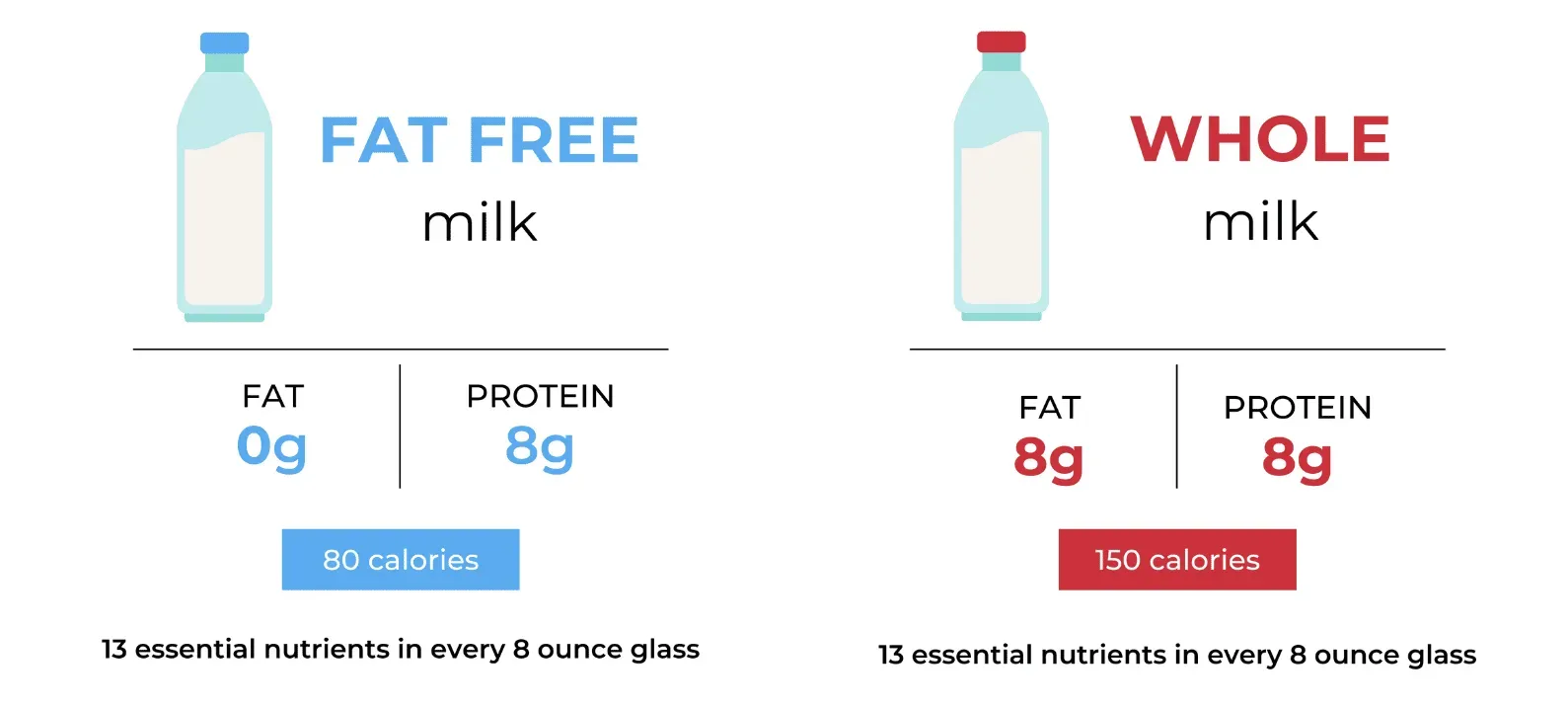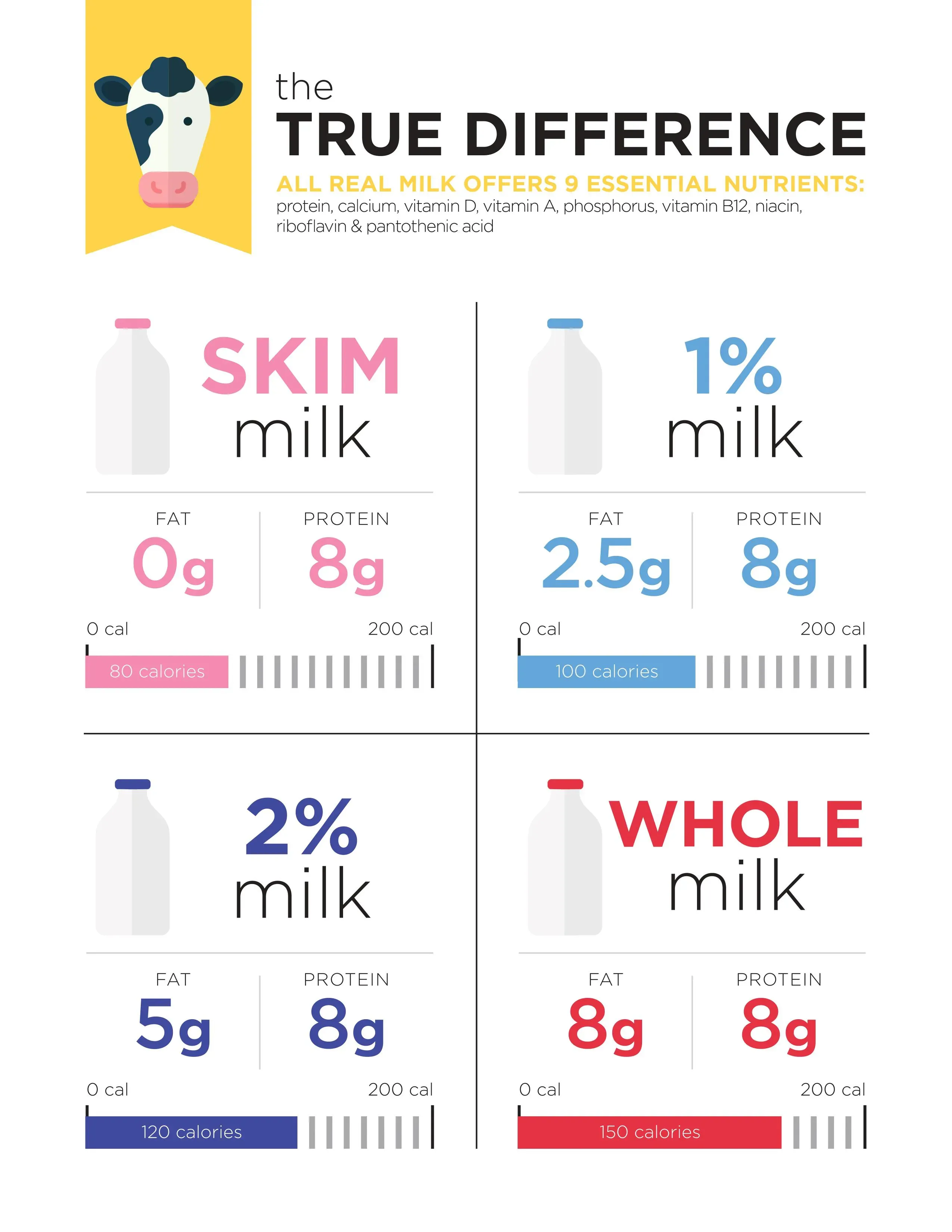Table of Contents
Walk into any grocery store dairy aisle, and you are faced with options. It is not just about brand anymore; it is about fat content. For years, the advice was clear: ditch the full-fat stuff and go for the leaner options. But the science on fats, especially dairy fat, has gotten a bit more complicated. So, what is the real story when comparing **whole milk and low fat milk**? Is one truly superior for your health, or does it depend on who you are and what you are trying to achieve?
The Basic Difference: Whole Milk vs. Low Fat Milk

The Basic Difference: Whole Milk vs. Low Fat Milk
When you grab a carton from the dairy case, the most immediate difference you see is usually on the label, right below the brand name: "Whole," "2% Reduced Fat," "1% Low Fat," or "Skim/Fat-Free." This percentage or description tells you the milk fat content by weight. Think of it like this: whole milk is the closest to how it comes from the cow, typically clocking in at around 3.25% milk fat. Low fat milk, on the other hand, has had most of that fat removed, leaving just 1% milk fat. There is also 2% milk, which falls somewhere in between, and skim milk, which has virtually no fat (less than 0.5%). So, the core distinction between **whole milk and low fat milk** boils down to how much fat remains after processing.
Beyond Fat: Nutritional Breakdown of Whole Milk and Low Fat Milk

Beyond Fat: Nutritional Breakdown of Whole Milk and Low Fat Milk
More Than Just Creaminess: Essential Nutrients
so we know the fat content is the headline difference between **whole milk and low fat milk**. But milk isn't just a delivery system for fat; it is packed with other stuff your body actually needs. We are talking about high-quality protein, that bone-building calcium everyone talks about, phosphorus, potassium, and a bunch of vitamins. Riboflavin and Vitamin B12? Check. These guys are crucial for energy and nerve function. Milk also naturally contains some Vitamin D, though many milks in the US are fortified with even more to help you absorb that calcium.
Think of it like this: stripping out the fat does not strip out *everything*. The protein punch remains pretty much the same across the board, whether you are drinking whole, 2%, 1%, or skim. Same goes for calcium and those B vitamins. So, if you are just chasing protein or calcium, the fat level is less of a dealbreaker than you might think initially.
Comparing Vitamins and Calories
Here is where the fat content starts to show its other effects. Fat-soluble vitamins – A, D, E, and K – are naturally present in milk fat. When you remove the fat to make low fat or skim milk, you lose some of these vitamins along with it. That is why milk processors typically add Vitamins A and D back into lower-fat versions; it is called fortification. So, while whole milk has these naturally, low fat milk has them added back in. Vitamin E and K are present in smaller amounts and aren't usually fortified.
The most obvious non-fat difference, besides texture and taste, is calories. Fat is calorie-dense. A cup of whole milk carries more calories than a cup of low fat milk simply because of its higher fat content. This is a key factor for anyone managing their calorie intake, though the difference might not be as massive as some imagine.
Nutrient (per cup, approximate) | Whole Milk (3.25% Fat) | Low Fat Milk (1% Fat) |
|---|---|---|
Calories | 150 | 100 |
Total Fat | 8g | 2.5g |
Saturated Fat | 5g | 1.5g |
Protein | 8g | 8g |
Calcium | 300mg (23% DV) | 300mg (23% DV) |
Vitamin D (fortified) | 2.5mcg (13% DV) | 2.5mcg (13% DV) |
Vitamin A (natural + fortified) | 120mcg RAE (13% DV) | 150mcg RAE (17% DV) |
Saturated Fat Scrutiny: Whole Milk and Heart Health

Saturated Fat Scrutiny: Whole Milk and Heart Health
The Shifting Science on Dairy Fat
Alright, let's tackle the elephant in the room, or perhaps the cow in the pasture: saturated fat. For decades, the prevailing wisdom was simple: saturated fat equals clogged arteries equals heart attacks. Whole milk, being higher in saturated fat than low fat milk or skim, got lumped into the "bad for your heart" category. Dietary guidelines pushed us toward fat-free everything, based largely on the lipid hypothesis. The thinking was, cut saturated fat intake, lower cholesterol, lower heart disease risk. It seemed logical enough at the time, a straightforward equation.
But science rarely stays simple forever. More recent, robust research has started to challenge that rigid view, especially when it comes to saturated fat from dairy. Turns out, the matrix of nutrients in dairy, including calcium, protein, and other fatty acids, might interact in ways that mitigate the potential negative effects of saturated fat alone. Some studies even suggest that consuming full-fat dairy isn't associated with increased risk of heart disease, and in some cases, might even be linked to a lower risk of conditions like metabolic syndrome and type 2 diabetes. It is a complex picture, far messier than the simple "saturated fat is evil" narrative we were sold for years when comparing **whole milk and low fat milk**.
Weighing the Benefits: Who Should Drink Whole Milk or Low Fat Milk?

Weighing the Benefits: Who Should Drink Whole Milk or Low Fat Milk?
Considering Whole Milk: More Than Just Calories
So, who should lean towards the creamy side of the dairy aisle and pick up **whole milk and low fat milk**? Well, if you are dealing with growing kids, whole milk often gets the nod. They need more calories and fat for development, and let's be honest, most kids prefer the taste. For adults who are underweight or struggling to get enough calories, whole milk is an easy way to add nutrient-dense energy. Also, if you are intrigued by the newer science suggesting dairy fat is not the villain it was once made out to be, and perhaps even offers some benefits (like potentially helping with satiety or managing metabolic health markers), whole milk might appeal. It provides those fat-soluble vitamins naturally present in the fat, though remember lower-fat versions are fortified.
It is not just about weight or kids, either. Some people simply find whole milk more satisfying. The fat contributes to flavor and mouthfeel. If drinking whole milk helps you feel full and prevents you from reaching for less healthy snacks later, that is a point in its favor. It boils down to looking at your overall diet and health goals, not just isolating one nutrient in one food.
Opting for Low Fat Milk: Cutting Calories, Keeping Nutrients
On the flip side, when does low fat milk make more sense in the **whole milk and low fat milk** debate? The most straightforward reason is calorie management. If you are watching your daily calorie intake, switching from whole milk to low fat milk is an easy way to shave off around 50 calories per cup without sacrificing protein, calcium, or added Vitamin D and A. This can add up if you drink multiple glasses a day or use milk in cooking and cereals. For individuals advised by healthcare professionals to limit saturated fat intake based on specific health conditions or family history, low fat milk remains the standard recommendation from many health organizations, despite the evolving research.
Low fat milk also has a lighter texture that some people prefer, especially in things like coffee or smoothies. And for many, it is simply what they grew up drinking and are used to. The key takeaway here is that you still get a powerhouse of essential nutrients – protein, calcium, and those fortified vitamins – even when the fat is significantly reduced. It offers nutritional bang for fewer caloric bucks, which is a valid consideration for many dietary strategies.
- Choose Whole Milk if:
- You need more calories for growth or weight gain.
- You prefer the taste and texture.
- Newer research on dairy fat aligns with your health philosophy.
- Choose Low Fat Milk if:
- You are actively managing calorie intake.
- You are following traditional dietary guidelines for saturated fat.
- You prefer a lighter taste and texture.
- Your doctor recommends limiting fat intake.
Making Your Milk Choice: Whole Milk and Low Fat Milk for Your Diet
Alright, so after wading through the fat percentages, the vitamin charts, and the ever-shifting science on saturated fat, you might still be thinking, " but which one should *I* actually drink?" The truth is, there is no single, universally correct answer in the **whole milk and low fat milk** debate. Your best choice depends on your individual dietary needs, your overall calorie goals, any specific health conditions you have, and honestly, what you enjoy drinking. If you are hitting your calorie targets easily and watching saturated fat based on your doctor's advice, low fat milk makes perfect sense. It gives you all those core nutrients – protein, calcium, fortified vitamins – without the extra fat and calories. However, if you are active, need a bit more energy, find whole milk more satisfying (which might curb snacking), or if the latest research on dairy fat resonates with you, whole milk is a perfectly valid option that provides those same core nutrients plus naturally occurring fat-soluble vitamins and beneficial fatty acids like omega-3s.
Making the Milk Choice: It Depends
So, after sifting through the fat percentages and the evolving science, where do we land on the whole milk versus low fat milk debate? The simple answer is, it is not as simple as previously thought. While low fat options offer fewer calories and less saturated fat on paper, the body's response to dairy fat appears more complex than the old lipid hypothesis suggested. Whole milk brings slightly more calories and fat, yes, but potentially offers benefits like better absorption of fat-soluble vitamins and maybe even a surprising assist in feeling full. Ultimately, the "better" choice between whole milk and low fat milk hinges on your individual dietary needs, calorie goals, and overall eating pattern. Consult the data, consider your own body, and pour accordingly.
